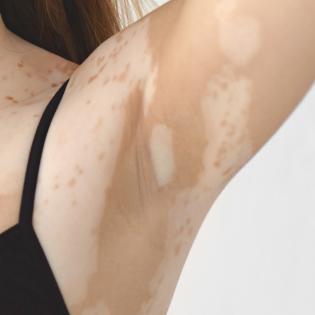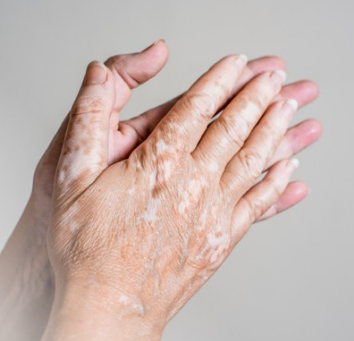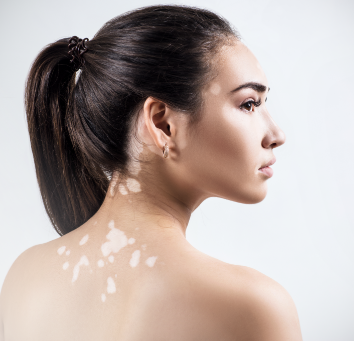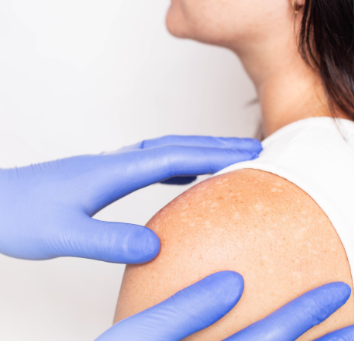Vitiligo is common,
but not contagious
It can be controlled
Understanding Vitiligo
Now that the bubble has been popped let us help you understand this skin disorder completely, rather than believing in myths. Research has shown that people with Vitiligo often suffer from embarrassment and anxiety due to its unpredictability.
You should understand the fact that it can happen to anyone of any gender. You shouldn’t treat people with Vitiligo differently. After all, there is nothing wrong with it; it’s just how their skin appears.
- Is a life-long condition.
- Affects 0.5 – 2% of the population.
- Affects people of all ages and gender.
- It is not contagious.
- It isn’t painful
What is Vitiligo?
It is a chronic skin disorder that causes some areas of the skin to lose its colour; this can happen anywhere on your body. In Vitiligo, the cells that give colour to your skin are destroyed. These melanocytes cells are unable to produce the skin pigment called melanin. Once the cells cannot produce melanin, your skin turns milky-white.
areas can be
→

Sun-exposed areas like face,
hands, arms, feet
01

Body openings like nostrils, ears, genitals
03

Body folds like armpits
02

Previously injured places
04
Symptoms of Vitiligo
The symptoms of Vitiligo are obvious, wherein the small milky-white patches start to appear on the skin. Premature greying of hair on the scalp, eyebrows, eyelashes or beard, the appearance of white patches inside your mouth and nose might indicate Vitiligo. It
does not cause any discomfort to your skin.
The two types of Vitiligo are quite different from each other although they look the same, but if you
notice Vitiligo spreads differently among people.
Non-segmental Vitiligo
The most common type of Vitiligo where the patches appear on both sides of your body as if they appear symmetrically. It is seen in 90% of the cases and spreads over time. This type of Vitiligo usually affects the body parts generally exposed to the sun.
This is further divided into 4 types.
→
01
Generalized
02
Acrofacial
03
Mucosal
04
Universal
Segmental Vitiligo
Segmental Vitiligo spreads faster and is usually developed in early ages like kids or teens. This type is rare and is seen only in 10% of the cases. It only affects one part of the body and appears non-symmetrically. It majorly appears on the skin that is attached to nerves. Hence it has a pinkish appearance.
Causes of Vitiligo
Causes 02
It is an autoimmune disease that stops the production of melanin in specific cells.
Causes 04
A defect in the melanocytes (the melanin-producing cells) results in self-destruction.
When to visit
a dermatologist?
You should see an expert when:
- You see a white patch on your body.
- When you see any premature hair growth on your
body. - When you lose the colour of the skin inside your
nose and mouth.
Treating Vitiligo
Vitiligo cannot be cured, but it can be stopped from spreading further or slowed for sure. The treatments also work differently for each individual. In some cases, it can be reversed if it is diagnosed early, and the treatment is started within 1-2 months of diagnosis.
Types of treatments:
- Epidermal cellular grafting
- Medicinal creams
- Laser therapy
- Depigmentation
- Types of surgery if nothing works
Treating Vitiligo
Vitiligo cannot be cured, but it can be stopped from spreading further or slowed for sure. The treatments also work differently for each individual. In some cases, it can be reversed if it is diagnosed early, and the treatment is started within 1-2 months of diagnosis.
Types of treatments:
- Epidermal cellular grafting
- Medicinal creams
- Laser therapy
- Depigmentation
- Types of surgery if nothing works
Know the whys and whats of Vitiligo
No, Vitiligo is not contagious and cannot spread from person to person.
No, Vitiligo does not cause any discomfort or pain. Although, the patch could feel a bit itchy and dry sometimes
In some cases, where early detection is done, Vitiligo can be cured.
No food allergy results in vitiligo. As a matter of fact, there are no food restrictions.
People with Vitiligo can live a normal life without any restrictions or limitations.




